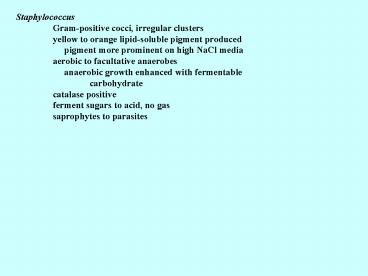Staphylococcus - PowerPoint PPT Presentation
1 / 22
Title:
Staphylococcus
Description:
food poisoning: diarrhea & vomiting. when expressed systemically, causes Toxic Shock ... S. aureus resistant to some antiseptics & disinfectants ... – PowerPoint PPT presentation
Number of Views:450
Avg rating:3.0/5.0
Title: Staphylococcus
1
Staphylococcus Gram-positive cocci, irregular
clusters yellow to orange lipid-soluble pigment
produced pigment more prominent on high
NaCl media aerobic to facultative anaerobes
anaerobic growth enhanced with
fermentable carbohydrate catalase
positive ferment sugars to acid, no
gas saprophytes to parasites
2
Staphylococcus inhabitants of skin, skin glands,
nasal mucosa of homeotherms some
pathogens - coagulase distinction
coagulase-positive - S. aureus
coagulase-negative (CNS) - 30 species CNS
commensals but some may cause infections S.
epidermidis most frequent isolate distinction
from S. aureus coagulase, mannitol
fermentation and pigmentation
3
Staphylococcus isolation blood agar
ß-hemolysis for S. aureus mannitol-salts agar
inhibits Gram-negative organisms CHROMagar MRSA
medium selective differential medium
for direct isolation of nasal MRSA strains
4
Staphylococcus characterization Vogel-Johns
on medium distinguish coagulase-positive,
mannitol-fermenting strains (Pathogenic
staphylococci also reduce tellurite to
metallic tellurium, thus their colonies turn
black in color.)
5
S. aureus infections boils, furuncles,
bullous impetigo, pneumonia, osteomyelitis
endocarditis, meningitis nosocomial
infections indwelling devices catheters,
artificial heart valves food poisoning
pathology dependent upon virulence factors
carried by the cell
6
Virulence factors adherence factors -
surface proteins bind to host cells
(fibronectin, collagen, etc.) (indwelling
devices coat with host proteins) avoidance
factor Protein A binds to Fc of
antibodies reduces phagocytosis
7
Virulence factors toxins a-toxin -
monocytes and platelets sensitive monomers
complex with each other, forming pore in cell
membrane pore releases cytokines which
cause inflammatory response may lead to
septic shock hypotension, hypoxia respiratory
failure, renal failure, intravascular
coagulation, hemorrhaging mortality in
septic shock 40-70 septic shock triggers
(i.e., LPS) cause vascular damage which releases
inflammatory mediators
8
- Virulence factors
- toxins
- ß-toxin sphingomyelinase, damages membranes
- ?-toxin leukocidin act together
- ?-toxin three genes in locus, A, B, C
- A B hemolytic, weakly leukotoxic B C
leukotoxin with poor hemolytic activity
Panton Valentine (PV) leukocidin potent
leukotoxin, non-hemolytic - induce inflammatory mediator release
from granulocytes major factor in
dermonecrotic lesions
9
Virulence factors toxins exfoliatin -
scalded skin syndrome in neonates blistering
and loss of epidermis appears to have
protease activity esterase activity potent
mitogens for T cells
10
Virulence factors toxins enterotoxin-
heat-stable 6 serotypes food poisoning
diarrhea vomiting when expressed
systemically, causes Toxic Shock TSST-1 toxin
related to enterotoxin responsible for 75
of all cases, including all menstrually related
cases enterotoxin B C cause of 50
of non-menstrual cases enterotoxin TSST are
superantigens normal antigen will activate
1 in 10,000 T cells superantigens may
activate 15-20 of T cells
11
Virulence factors other factors coagulase
staphylokinase plasminogen activator
12
Coagulase-negative Staphylococcus (CNS) S.
epidermidis few virulence factors distinction
from S. aureus coagulase mannitol
fermentation pigmentation S.
haemolyticus coagulase-negative ferments
mannitol ß-hemolytic
13
Staphylococcal diseases folliculitis,
boils, furuncles, carbuncles acute abcess
of skin subcutaneous tissues extreme
tenderness followed by swelling, pus
formation, then spontaneous draining
14
Staphylococcal diseases boils, furuncles,
carbuncles acute abcess of skin
subcutaneous tissues extreme tenderness
followed by swelling, pus formation, then
spontaneous draining
15
Staphylococcal diseases folliculitis,
boils, furuncles, carbuncles acute abcess
of skin subcutaneous tissues extreme
tenderness followed by swelling, pus
formation, then spontaneous draining Folliculiti
s red bumps with or without very small
collections of pus fluid at the top red bump
always centered around individual hair follicles
and can be located anywhere there is hair on the
body including the nose, eyelids, genital organs,
and anus Furuncles collections of several hair
follicles that are inflamed, red, and infected
the next step of progression of staph infection
from folliculitis where several areas of
folliculitis occur close
16
Staphylococcal diseases Carbuncles collections
of many, many infected hair follicles that
combine together to form a large skin abscess
that is commonly referred to as a boil these
abscesses are mistaken as spider bites even by
physicians. There is a tendency for carbuncles
to form on near the genitals or near the anus.
17
Staphylococcal diseases wound
infections (primarily S. aureus) purulent
drainage associated factors age, steroid
administration, obesity, malnutrition,
diabetes, other infections breast
infections - mastitis generally in newborns and
women esp. after labor pain lump may be more
extensive
18
Staphylococcal diseases pneumonia a.
lobar pneumonia acute illness with high
fever cough with yellow bloody sputum
containing cocci neutrophils b. diffuse
interstitial pneumonia accompanied by or
follows influenza tachypnea cyanosis c.
localized areas of pneumonia secondary to
septic emboli with infarction
bacteremia bacteremia with endocarditis
chest pain, fever, chills, rapid breathing
with pain
19
Staphylococcal diseases endocarditis acut
e fulminant illness high fever metastatic
abcesses potential for lethal damage to heart
valves in prosthetic heart valve cases - gt40
caused by CNS bacteremia - from any site,
often CNS high fever, tachycardia, often
shock blood coagulation may occur underlying
disease - diabetes, leukemia
20
Staphylococcal diseases food
poisoning onset 30 min to 7 hr, duration 24
hr abrupt onset severe nausea and
cramps followed by diarrhea, vomiting,
prostration usually no fever toxic shock
syndrome fever, erythematous macular rash which
peels falling blood pressure
meningitis 1-9 of all bacterial cases fever,
stiff neck
21
Staphylococcal diseases scalded skin
syndrome abrupt onset with diffuse
erythema skin very sensitive to touch 1-2 days,
begins to peel with light touch
22
Treatment S. aureus resistant to most
antibiotics Methicillin was drug of choice now
MRSA common methicillin resistant strains
also resistant to many other
antibiotics Vancomycin still effective, but
resistance appearing S. aureus resistant to
some antiseptics disinfectants survives
in some environments - hospital































